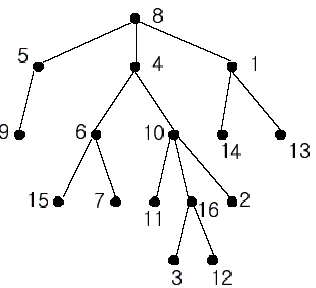lca入门———树上倍增法(博文内含例题)
倍增求LCA:
father【i】【j】表示节点i往上跳2^j次后的节点
可以转移为
father【i】【j】=father【father【i】【j-1】】【j-1】
整体思路:
先比较两个点的深度,如果深度不同,先让深的点往上跳,浅的先不动,等两个点深度一样时,if 相同 直接返回,if 不同 进行下一步;如果不同,两个点一起跳,j从大到小枚举(其实并不大),如果两个点都跳这么多后,得到的点相等,两个点都不动(因为有可能正好是LCA也有可能在LCA上方),知道得到的点不同,就可以跳上来,然后不断跳,两个点都在LCA下面那层,所以再跳1步即可,当father【i】【j】中j=0时即可,就是LCA,返回值结束
(摘自http://blog.csdn.net/dad3zz)
在网络海洋中搜寻很久后找到hzwer的宽搜求deep序,进行了学习。
以下是我的模板代码:
构造访问数组!
void make_bin()
{
bin[0]=1;
for(int i=1;i<=15;i++)
bin[i]=bin[i-1]<<1;
}
简明易懂邻接表!
void Link()
{
for(int i=1;i<=n-1;i++){//n-1 edges;or you can define a m pointing to the number of edges;
scanf("%d%d",&u[i],&v[i]);
u[i+n-1]=v[i];v[i+n-1]=u[i];//双向;
next[i]=first[u[i]];
next[i+n-1]=first[v[i]];//双向;
first[u[i]]=i;
first[v[i]]=i+n-1;//双向;
isroot[v[i]]=true;
}
}
宽搜!
void bfs()
{
int head=0,tail=1;
q[0]=root,vis[root]=true;
while(head^tail){
int now=q[head];head++;
for(int i=1;i<=15;i++){
if(bin[i]<=deep[now])
fa[now][i]=fa[fa[now][i-1]][i-1];
else break;
}
for(int i=first[now];i;i=next[i])
if(!vis[v[i]]){
vis[v[i]]=true;
fa[v[i]][0]=now;
deep[v[i]]=deep[now]+1;
q[tail++]=v[i];
}
}
}
求lca()
int lca(int x,int y)
{
if(deep[x]<deep[y])swap(x,y);
int t=deep[x]-deep[y];
for(int i=0;i<=15;i++)
if(t&bin[i])x=fa[x][i];
for(int i=15;i>=0;i--)
if(fa[x][i]^fa[y][i])
x=fa[x][i],y=fa[y][i];
if(!(x^y))return y;
return fa[x][0];
}
之后,在poj上找了一个众所周知的例题,poj1330,当做lca入门题
| Time Limit: 1000MS | Memory Limit: 10000K | |
| Total Submissions: 24757 | Accepted: 12864 |
Description

In the figure, each node is labeled with an integer from {1, 2,...,16}. Node 8 is the root of the tree. Node x is an ancestor of node y if node x is in the path between the root and node y. For example, node 4 is an ancestor of node 16. Node 10 is also an ancestor
of node 16. As a matter of fact, nodes 8, 4, 10, and 16 are the ancestors of node 16. Remember that a node is an ancestor of itself. Nodes 8, 4, 6, and 7 are the ancestors of node 7. A node x is called a common ancestor of two different nodes y and z if node
x is an ancestor of node y and an ancestor of node z. Thus, nodes 8 and 4 are the common ancestors of nodes 16 and 7. A node x is called the nearest common ancestor of nodes y and z if x is a common ancestor of y and z and nearest to y and z among their common
ancestors. Hence, the nearest common ancestor of nodes 16 and 7 is node 4. Node 4 is nearer to nodes 16 and 7 than node 8 is.
For other examples, the nearest common ancestor of nodes 2 and 3 is node 10, the nearest common ancestor of nodes 6 and 13 is node 8, and the nearest common ancestor of nodes 4 and 12 is node 4. In the last example, if y is an ancestor of z, then the nearest
common ancestor of y and z is y.
Write a program that finds the nearest common ancestor of two distinct nodes in a tree.
Input
labeled with integers 1, 2,..., N. Each of the next N -1 lines contains a pair of integers that represent an edge --the first integer is the parent node of the second integer. Note that a tree with N nodes has exactly N - 1 edges. The last line of each test
case contains two distinct integers whose nearest common ancestor is to be computed.
Output
Sample Input
2
16
1 14
8 5
10 16
5 9
4 6
8 4
4 10
1 13
6 15
10 11
6 7
10 2
16 3
8 1
16 12
16 7
5
2 3
3 4
3 1
1 5
3 5
Sample Output
4
3
Source
Source Code
| Problem: 1330 | User: ksq2013 | |
| Memory: 1224K | Time: 32MS | |
| Language: C++ | Result: Accepted |
ac代码如下:
#include<cstdio>
#include<cstring>
#include<iostream>
using namespace std;
bool vis[10100],isroot[10100];
int root,q[10100],deep[10100],fa[10100][20];
int n,bin[20],first[10100],next[10100],u[10100],v[10100];
void make_bin()
{
bin[0]=1;
for(int i=1;i<=15;i++)
bin[i]=bin[i-1]<<1;
}
void Link()
{
for(int i=1;i<=n-1;i++){
scanf("%d%d",&u[i],&v[i]);
//u[i+n-1]=v[i];v[i+n-1]=u[i];
next[i]=first[u[i]];
//next[i+n-1]=first[v[i]];
first[u[i]]=i;
//first[v[i]]=i+n-1;
isroot[v[i]]=true;
}
for(int i=1;i<=n;i++)
if(!isroot[i]){
root=i;
break;
}
}
void bfs()
{
int head=0,tail=1;
q[0]=root,vis[root]=true;
while(head^tail){
int now=q[head];head++;
for(int i=1;i<=15;i++){
if(bin[i]<=deep[now])
fa[now][i]=fa[fa[now][i-1]][i-1];
else break;
}
for(int i=first[now];i;i=next[i])
if(!vis[v[i]]){
vis[v[i]]=true;
fa[v[i]][0]=now;
deep[v[i]]=deep[now]+1;
q[tail++]=v[i];
}
}
}
int lca(int x,int y)
{
if(deep[x]<deep[y])swap(x,y);
int t=deep[x]-deep[y];
for(int i=0;i<=15;i++)
if(t&bin[i])x=fa[x][i];
for(int i=15;i>=0;i--)
if(fa[x][i]^fa[y][i])
x=fa[x][i],y=fa[y][i];
if(!(x^y))return y;
return fa[x][0];
}
int main()
{
make_bin();
int T;
scanf("%d",&T);
for(;T;T--){
memset(vis,false,sizeof(vis));
memset(isroot,false,sizeof(isroot));
memset(q,0,sizeof(q));
memset(fa,0,sizeof(fa));
memset(deep,0,sizeof(deep));
memset(first,0,sizeof(first));
memset(next,0,sizeof(next));
scanf("%d",&n);
Link();
bfs();
int x,y;
scanf("%d%d",&x,&y);
printf("%d\n",lca(x,y));
}
return 0;
}
lca入门———树上倍增法(博文内含例题)的更多相关文章
- 最近公共祖先算法LCA笔记(树上倍增法)
Update: 2019.7.15更新 万分感谢[宁信]大佬,认认真真地审核了本文章,指出了超过五处错误捂脸,太尴尬了. 万分感谢[宁信]大佬,认认真真地审核了本文章,指出了超过五处错误捂脸,太尴尬了 ...
- 树上倍增法求LCA
我们找的是任意两个结点的最近公共祖先, 那么我们可以考虑这么两种种情况: 1.两结点的深度相同. 2.两结点深度不同. 第一步都要转化为情况1,这种可处理的情况. 先不考虑其他, 我们思考这么一个问题 ...
- 【37.48%】【hdu 2587】How far away ?(3篇文章,3种做法,LCA之树上倍增)
Time Limit: 2000/1000 MS (Java/Others) Memory Limit: 32768/32768 K (Java/Others) Total Submission(s) ...
- LCA离线Tarjan,树上倍增入门题
离线Tarjian,来个JVxie大佬博客最近公共祖先LCA(Tarjan算法)的思考和算法实现,还有zhouzhendong大佬的LCA算法解析-Tarjan&倍增&RMQ(其实你们 ...
- Codeforces 609E (Kruskal求最小生成树+树上倍增求LCA)
题面 传送门 题目大意: 给定一个无向连通带权图G,对于每条边(u,v,w)" role="presentation" style="position: rel ...
- HDU 2586 倍增法求lca
How far away ? Time Limit: 2000/1000 MS (Java/Others) Memory Limit: 32768/32768 K (Java/Others)To ...
- 最近公共祖先 LCA 倍增法
[简介] 解决LCA问题的倍增法是一种基于倍增思想的在线算法. [原理] 原理和同样是使用倍增思想的RMQ-ST 算法类似,比较简单,想清楚后很容易实现. 对于每个节点u , ancestors[u] ...
- 最近公共祖先 LCA (Lowest Common Ancestors)-树上倍增
树上倍增是求解关于LCA问题的两个在线算法中的一个,在线算法即不需要开始全部读入查询,你给他什么查询,他都能返回它们的LCA. 树上倍增用到一个关键的数组F[i][j],这个表示第i个结点的向上2^j ...
- 【bzoj4940】[Ynoi2016]这是我自己的发明 DFS序+树上倍增+莫队算法
题目描述 给一个树,n 个点,有点权,初始根是 1. m 个操作,每次操作: 1. 将树根换为 x. 2. 给出两个点 x,y,从 x 的子树中选每一个点,y 的子树中选每一个点,如果两个点点权相等, ...
随机推荐
- 【C语言】C语言static和extern区别
目录: [static] [extern] 1.static · 定义一个内部函数/变量. · 声明一个内部函数/变量. 2.extern · 定义一个外部函数/变量. · 声明一个外部函数/变量. ...
- mac 终端启动 jboss 停留在(Starting) 不能启动joss
今天下载了jboss,解压后发现standalone.sh,不能够在终端中执行,于是google了一下,原来是由于jdk版本的问题导致jboss一直停在调试状态(貌似是这样说的). 需要把mac系统的 ...
- 你真的了解UIControl吗?
一:首先查看一下关于UIControl的定义 NS_CLASS_AVAILABLE_IOS(2_0) @interface UIControl : UIView //控件默认是启用的YES.是否要禁用 ...
- 【代码笔记】iOS-判断中英文混合的字符长度的两种方法
一,代码. - (void)viewDidLoad { [super viewDidLoad]; // Do any additional setup after loading the view. ...
- 【读书笔记】iOS网络-理解错误源
考虑一个字节是如何从设备发往运程服务器以及如何从远程服务器将这个字节接收到设备,这个过程只需要几百毫秒时间,不过确要求网络设备都能正常工作才行.设备网络和网络互联的复杂性导致了分层网络的产生.分层网络 ...
- 认识Activity,创建第一个android应用-Hello Word
2016-04-05 配置好Java.eclipse和Android环境就花费了一天时间.下载SDK真是费了不少时间.现在终于找到解决SDK更新的好方法了(更新自己电脑上的hosts文件,就可以使用G ...
- 关于Storyboard的使用
前言:说起来码龄很久似的,但是还是有很多基础的知识都不知道,比如下面介绍的关于Stroyboard的使用.(本篇博文随笔会不断补充关于Storyboard的使用技巧,持续更新) 目录: 1.使用Str ...
- php中的cookie用法
cookie和session都可以暂时保存在多个页面中使用的变量,但是它们有本质的差别. cookie存放在客户端浏览器中,session保存在服务器上.它们之间的联系是session ID一般保存在 ...
- Play Framework 完整实现一个APP(一)
A blog engine project yabe. 1.创建工程 >play new yabe 设置Application Name: Yet Another Blog Engine. 2. ...
- 持续集成(CI)初探
前不久接触了持续集成(Continuous Integration,CI). 一.持续集成是什么 首先说说“集成”的概念.在实际的软件开发中,常常会发生两种情境: 1.几个项目组对同一个系统的不同功能 ...
